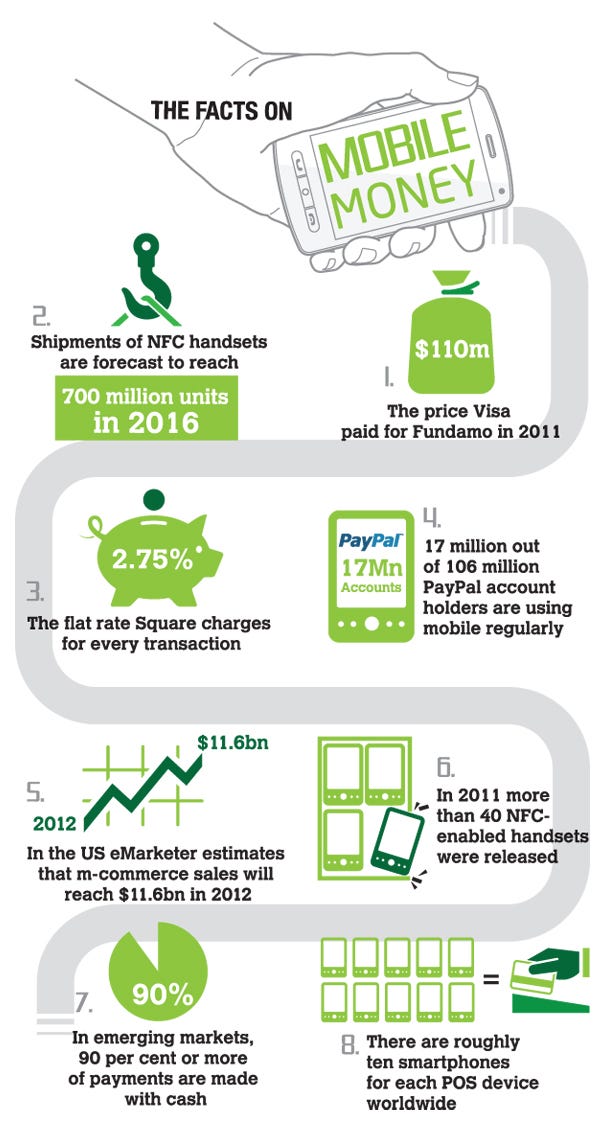Transaction Stations
Mobile financial services are back in the news, making for a substantial share of the announcements made at February’s Mobile World Congress. The aim is as simple as the ecosystem is complex, and structuring a play in this space is no mean feat.
April 25, 2012


High profile news announcements about mobile financial services have become almost a daily occurrence. While they vary from one to the next—perhaps showcasing cross-sector partnerships, the strategic initiatives of individual players, or vendor contract wins—collectively they indicate a central fact: The long-awaited, wide scale collision of mobility with banking and commerce has arrived.
Of course services like Safaricom’s m-Pesa, and the long-standing use of text messaging as a means of peer-to-peer (P2P) value transfer in markets like the Philippines, have been making mobile financial services a reality for some years now. But these markets are fundamentally different from much of the world because the absence of banking infrastructure in many emerging markets created a vacuum that increased the pull on mobile financial services, accelerating deployment and uptake.
This does nothing to diminish the huge strides made by players in these markets, but it does help to illustrate why the situation has been so much more complicated in mature economies. In these markets the banks are more entrenched than the mobile operators, with churn rates that MNOs could only dream about. The majority of adults have had some kind of bank account longer than they’ve had a mobile phone and, while the shift away from this norm has already begun, the vested interests of the financial services players represent a huge challenge to mobile operators’ ambition.
These two groups of companies, and the tussle for power between them, have for many years provided the central narrative of the mobile financial services story in mature markets—with which this issue of MCI concerns itself. A decade or more ago there was much talk that operators would apply for banking licences, or that banks would buy operators or become MVNOs. There have been a small number of developments along these lines but the reality is that each of the two protagonists in this tale have had more pressing things to deal with in the interim than a two-footed leap into another sphere of business altogether.
Today everyone must be seen to stress the importance of collaboration and co-opetition. But behind the press-call handshakes it is clear enough that the central power struggle between mobile and financial players for the opportunity that lies at their intersection is unresolved.
“Like a lot of businesses where new technology has a disruptive role, some organisations have to simultaneously hold opposing views,” says David Birch, director at mobile transaction specialists Consult Hyperion. “Everyone has to be nice to everyone else and pretend all the stakeholders are cooperating on a new ecosystem. But deep down inside they’re hoping they can take over the ecosystem themselves—that’s just business. So inevitably, it’s still a battleground.”
The intensity of this struggle is fed by the presence and aims of the other players in the ecosystem. Handset manufacturers, payment schemes, regulators and retailers all have influence over the fortunes of the banks and the operators—and must be involved to their own satisfaction if anyone is to succeed.
Hovering on the edge of this group of venerable players are newer, digital disruptors, over the top service providers and—in all likelihood—as yet unknown start-ups that stand to make gains in the space. The threat they represent—that large organisations often lack the fleetness of foot necessary to capitalise on emerging opportunities—is familiar to the mobile operators, but may be less so to the financial community. And, in combination, those large organisations are likely to be slower, not faster than they are alone.
“If you go to a lot of banking conferences,” warns David Hodgkinson, a consultant specialising in financial services at KPMG, “you do find that a lot of the debate is over who owns the customer. I think if the banks and the MNOs spend all their time arguing over this issue, then the OTT players will come in with a focus on delivering a good customer experience and clean up.”
The convolution in this space derives from more than just the variety of stakeholders. There is a mind-boggling cascade of services, of business models and of enabling technologies and applications. There are more ways to part with money in a mobile financial services environment than any consumer could hope to grasp or master—and no new paradigm ever succeeded by confusing the customer.
For all its complexity, however, the MFS sector has a fundamentally simple premise as its aim. And there is a very real risk that the complexity behind the scenes could infect the simplicity of the consumer facing offers.
So what kind of services huddle beneath the MFS umbrella? Mobile banking offers users the chance to manage their accounts from their handset, as they have become used to doing online. Mobile payment covers everything from P2P transfer to invoicing, physical retail and a version of remote purchasing that, again, is recognisable from the desktop internet. Advertising, couponing and virtual currencies are mixed in for good measure—and everything, as some would have it, will sit in the mobile wallet.
Individually some of these services are easy enough to delineate in terms of ownership. It seems clear, for example, that the banks should and will retain control over mobile banking services. While they have not been universally quick off the mark in giving users mobile-specific applications that allow them to access their current financial information, many banks have now made a range of options available, from text updates to more dynamic smartphone apps. Mobile operators have little reason to be involved in this, other than as the transport mechanism.
Beyond this, however, when the services become more transactional in nature, the two sides collide. Operators see their provision of mobile access, personal identification and security as the added value to a transaction that, at its simplest, represents a consumer taking and spending some of their own money. Banks, meanwhile, see themselves as the guardians of that money, and their involvement in its movement as paramount. As Gerhard Romen, director of mobile financial services at Nokia and chair of the marketing working group at the Mobey Forum puts it: “Whenever you talk about money holding or transfer you’re talking about something that’s core business to the banks, and it makes sense to have them involved as a control point.”
While both banks and operators stand accused at times of being comparatively slow to innovate around new opportunities, the operators can justifiably lay claim to being the nimbler of the two groups. But, says David Hodgkinson, they can no longer assume that their expertise in the world of new consumer technology guarantees their leadership in the MFS space.
Hodgkinson says that, 18 months ago, he would have bet on the operators to emerge as the leaders in the sector. They were consumer-driven, responsive, comparatively skilled in CRM, gatekeepers of handset provision, and ahead of the game in managing affiliate relationships. The banks, on the other hand, were affected by trust issues born out of the global financial crisis, and directionless in their approach to mobile, although aware that they needed to shape a mobile offering.
Today he puts his money on the banks emerging as the stronger of the two camps. “We’ve seen banks recruiting from telcos and card schemes and other consumer businesses. They’ve plugged the ideas gap with people who are well versed in the consumer experience,” he says. “They are also in a strong position because of the investment that »
Visa and Mastercard have put into this space. The banks are going to make money out of any card-linked offering, and they will reap financial benefits from the erosion of cash.”
But not everyone from the banking community agrees that banks have their mobile ducks in a row. For banks, mobile needs to be about more than customers’ transactions, says Michael Nuciforo director of mobile banking consultancy Keatan. The mobile offers banks opportunities in four areas, he says—cost reduction, customer retention, customer acquisition and new revenue—and it is not being exploited as well as it should be.
“Most banks have focused on cost reduction,” says Nuciforo, “migrating transactions away from higher cost channels like the branch and voice telephony. But what we’re starting to see is that the majority of transactions being migrated to mobile are actually coming from internet banking. The challenge with this transaction shift is that they’re moving from a high sales channel—online banking—to mobile, which is a low sales channel. Mobile probably ranks alongside the ATM in terms of sales capability. If this is not addressed, it will lead to a decline in banks’ internet sales.”
As banks look to improve their own use of mobile as a sales and marketing channel they will move to embrace affiliate marketing within the environments that they control, says David Hodgkinson. “Just a year ago banks were saying that affiliate and third party offers were a bit tacky and they weren’t sure it would fit with their brands,” he says. “Those same banks are now falling over themselves to launch that kind of service.”
This is one area that a number of operators have identified as key to their growth and, if Hodgkinson is right, then it suggests that the battleground will be the mobile wallet—of which payment and transaction are just single elements—rather than the payments and transactions themselves.
The standard response from operators is that they hold the key to the security of mobile financial services, with the SIM the most natural place for the secure element to reside. But while this has been accepted by much of the operator community, and is the default position of GSMA, which advocates renting of space on the SIM to organisations with applications that require rigorous security, it’s not the only game in town.
SIM-based security is bound to the use of NFC as the connection mechanism and, while some deployments are established and others underway, there is great debate as to when this technology will become sufficiently widespread to hit critical mass. This brings retailers into the equation. They decide which solutions are accepted in their stores and on their websites and hold some of the strongest cards in game that has ubiquitous mobile financial services as its conclusion.
All of these issues are investigated, alongside interviews with the companies trying to make this sector a commercial reality. Such is the vibrancy of the sector, and such is the range of companies involved within it, we could have filled many more pages.
Read more about:
DiscussionAbout the Author(s)
You May Also Like











_1.jpg?width=300&auto=webp&quality=80&disable=upscale)


.png?width=800&auto=webp&quality=80&disable=upscale)